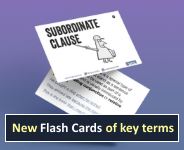Orientating a scene: prepositions in travel guides
Goals
- To understand how prepositions construct meaning in a non-fiction text.
- For students to apply this to their own writing.
What and how do prepositions mean?
Begin by showing your class a list of prepositions (or - even better - ask them to generate the list themselves). Display the list on the board, and ask: what do prepositions do and how do they do it? The discussion should arrive at the following conclusions:
- Prepositions link other words, phrases and clauses together.
- They express relations in space and in time.
The language of audio guides
This activity looks at prepositions in a genre of writing: audio guides. This is an interesting genre to look at because one purpose of this kind of writing is to ask the reader to imagine that the speaker is there with them. The speaker of the text therefore orientates the listener in relation to the physical space - and so makes extensive use of prepositions. Read the following text with your students (also available on the handout below), which is an (adapted) audio guide from here. You could even ask a couple of students to act out the scene, imagining that they are listening to the audio guide as somebody reads it out loud
Now, let's walk into the British Museum and get started! The tour begins with the Great Court. The main entrance spills you into the Great Court - a glass domed space with the round reading room in the centre. Here you will find guides, a book store, toilets and eateries. Don't forget to look up at the magnificent glass ceiling. This delightful court was for over 150 years one of London's great lost spaces, closed off and gathering dust. Renovated in the year 2000, it is now the symbol of the museum. From the Great Court, doorways lead to all wings of this vast museum. To the left are the exhibits on Egypt, Syria and Greece, and that is what our tour covers. Start heading to the left side of the round reading room, where you'll find the entrance to the Egyptian gallery. Let's go!
After reading, ask students to discuss the following questions:
- Does the audio guide do a good job of helping the listener navigate the museum?
- Which words and phrases help the reader to navigate the museum?
Their answers might include the following points, which you might also share with your students:
- The text includes interesting historical information about the building.
- Adjectives and noun phrases help to generate a sense of interest and imagery (e.g. a glass domed space; this delightful court).
- The second-person pronoun you addresses the listener directly, which creats a conversational and personal tone.
- Preposition phrases help to orientate the listener and provide directions (e.g. to the left...)
Focusing on prepositions
Next, let's focus on the use of prepositions and preposition phrases in the text, and think about why they are used. To do this, ask your students to first find all of the prepositions and preposition phrases and write them out in a column. It doesn't matter so much if your students don't find every single one, but here is the complete list of preposition phrases:
- into the British Museum
- with the Great Court
- into the Great Court
- with the round reading room
- in the centre
- at the magnificent glass ceiling
- for over 150 years
- in the year 2000
- of the museum
- from the Great Court
- to all wings
- of this vast museum
- to the left
- on Egypt, Syria and Greece
- to the left side
- of the round reading room
- to the Egyptian gallery
Now ask your students: what do you notice about this list? What patterns can you see, and why do you think those patterns are there, considering what type of text this is? Their ideas might include:
- Most preposition phrases indicate locations, which is understandable given that the text is describing a physical location.
- The prepositions indicating locations generally ask the reader to look at different things in the building, or to move to different locations.
- There are a couple of time prepositions, which tell us more information about significant dates in the building's history.
Creating an audio guide
For this writing task, students apply some of the grammatical features they have explored into a writing task of their own. Ask students to create an audio guide of their own, either based on a tour of the classroom/school, or you could ask them to do it for their own home. They should think carefully about their language choices, considering the use of the following and how they construct meaning:
- The use of place preposition phrases in helping the listener to navigate the space.
- The use of time preposition phrases in providing more information about the physical space.
- Use of pronouns and terms of address.
- Verb choices and the different ways they would like the listener to move (e.g. walk, turn, face, open, stop).
Once finished, students should write a short 'linguistic commentary' on their own writing, analysing some of their language choices by providing examples and discussing how they construct meaning.
Welcome!

Englicious is totally free for everyone to use!
But in exchange, we ask that you register for an account on our site.
If you’ve already registered, you can log in straight away.
Since this is your first visit today, you can see this page by clicking the button below.
- Printer-friendly version
- Log in to view or leave comments

